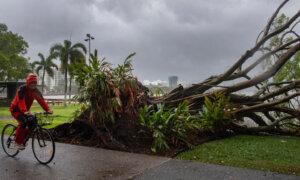Weather forecasters are predicting an eclectic mix of weather conditions across the Southern Hemisphere as a hot summer looms—and it could be a volatile season depending on who you ask.
A Bureau of Meteorology (BoM) spokesperson said September would see the heat turned up across a large section of Australia.
“For the second half of September, above average maximum temperatures are likely to very likely—a 60 percent to greater than 80 percent chance—for most of eastern Australia and across the north,” they told The Epoch Times.
“In the west, maximum temperatures are likely to be within the typical seasonal range.”
The spokesperson gave similar predictions for October to December.
Northern Western Australia, southern Northern Territory, northern Queensland, and Tasmania had the highest chance to reach unusually high maximum temperatures during this period—comparable to the warmest 20 percent of October-December periods from 1981-2018.
The BoM said it was difficult to determine if gales would be a factor as wind was only predicted for seven days—but there were some indictors to back reports gales may be on the way for the Southern Hemisphere.
“We can get an indication of regions more likely to see gales from long-range forecasts of mean sea level pressure (MLSP),” the spokesperson said.
“Bureau long-range forecasts for the second half of September and for October indicate that below average MSLP is likely for southern Australia, increasing the chances of gales in that region.”
Greater Extremes
A spokesman for New Zealand’s Hauraki Gulf Weather told The Epoch Times that recent heat waves and extreme wind in Australia was a sign of things to come.“In simple terms, the Southern Hemisphere mid latitude countries like New Zealand, Australia, Chile, Argentina, and South Africa are going to be windier and stormier than usual with hotter and colder temperature extremes during September into October,” he said.
According to Hauraki Gulf Weather, July’s unusual warmth across the Southern Hemisphere had combined with colder temperatures like those felt recently in New Zealand to create the perfect recipe for wind.
Conditions are comparable to similar weather patterns in September 2002, which forecasters say could help guide predictions—namely involving a “vigorous belt of westerly winds” likely to arrive in Australia and New Zealand during September.
Though the BoM is somewhat measured in its outlook.
The Bureau says it is usually only during very strong spring warming episodes that stratospheric polar vortex conditions—like those being studied by Hauraki Gulf Weather—are likely to impact weather close to the earth’s surface.
However, forecasters say they will continue to monitor weather patterns closely.







